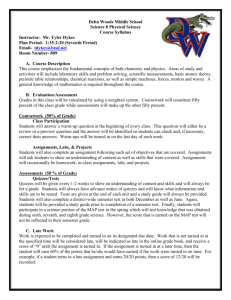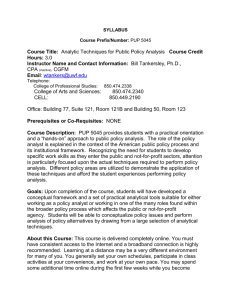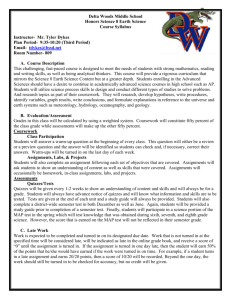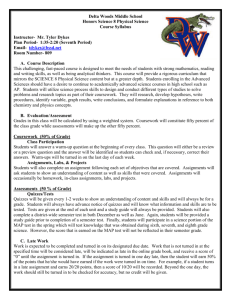Course Syllabus
advertisement
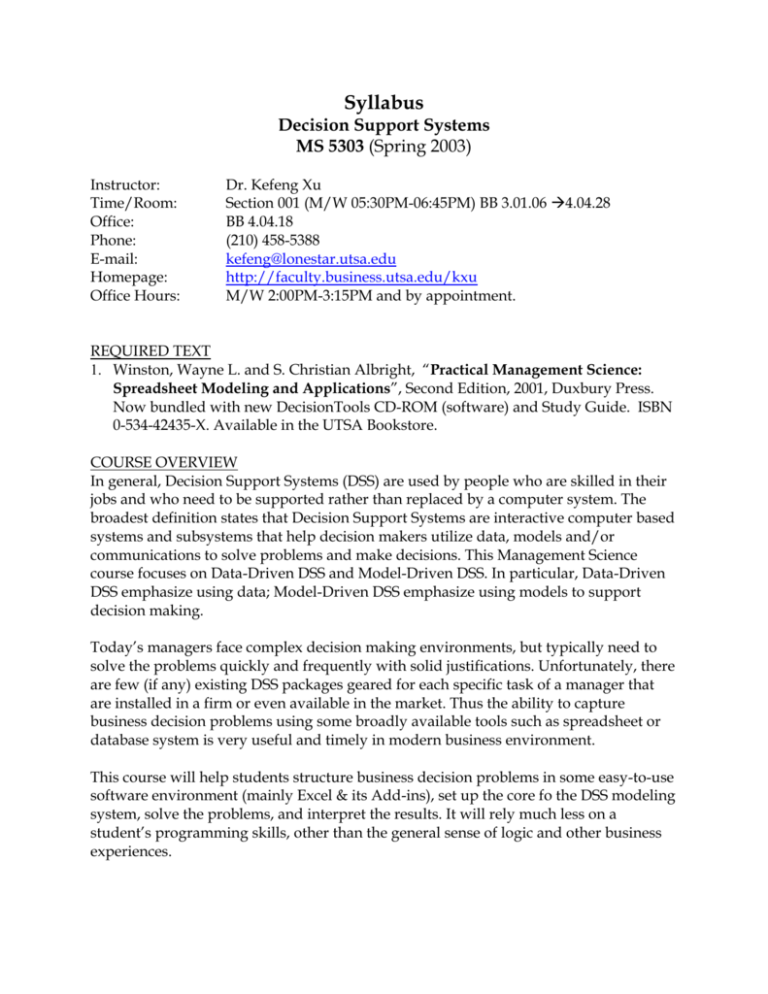
Syllabus Decision Support Systems MS 5303 (Spring 2003) Instructor: Time/Room: Office: Phone: E-mail: Homepage: Office Hours: Dr. Kefeng Xu Section 001 (M/W 05:30PM-06:45PM) BB 3.01.06 4.04.28 BB 4.04.18 (210) 458-5388 kefeng@lonestar.utsa.edu http://faculty.business.utsa.edu/kxu M/W 2:00PM-3:15PM and by appointment. REQUIRED TEXT 1. Winston, Wayne L. and S. Christian Albright, “Practical Management Science: Spreadsheet Modeling and Applications”, Second Edition, 2001, Duxbury Press. Now bundled with new DecisionTools CD-ROM (software) and Study Guide. ISBN 0-534-42435-X. Available in the UTSA Bookstore. COURSE OVERVIEW In general, Decision Support Systems (DSS) are used by people who are skilled in their jobs and who need to be supported rather than replaced by a computer system. The broadest definition states that Decision Support Systems are interactive computer based systems and subsystems that help decision makers utilize data, models and/or communications to solve problems and make decisions. This Management Science course focuses on Data-Driven DSS and Model-Driven DSS. In particular, Data-Driven DSS emphasize using data; Model-Driven DSS emphasize using models to support decision making. Today’s managers face complex decision making environments, but typically need to solve the problems quickly and frequently with solid justifications. Unfortunately, there are few (if any) existing DSS packages geared for each specific task of a manager that are installed in a firm or even available in the market. Thus the ability to capture business decision problems using some broadly available tools such as spreadsheet or database system is very useful and timely in modern business environment. This course will help students structure business decision problems in some easy-to-use software environment (mainly Excel & its Add-ins), set up the core fo the DSS modeling system, solve the problems, and interpret the results. It will rely much less on a student’s programming skills, other than the general sense of logic and other business experiences. COURSE OBJECTIVES This Management Science course is aimed at extending business students’ knowledge and expertise in various decision making scenarios. This course assumes prior knowledge and work with computers and basic knowledge of management science. Students are expected to: skillfully build customized or ad hoc computer models for use in decision support, based on spreadsheet modeling; effectively present information derived from computer models, and interpret model results, gain insights from the models, and draw conclusions supported by the results. This will give students a first-hand experience with modeling a real world situation for better decision making, and expose students to models from various business fields. Students can use the project presentations to relay and discuss their experiences in building DSSs. STUDENT REQUIREMENTS Some fundamental knowledge of management science and statistics (such as those in MS 5023 or MS 3033) is very helpful. No strong computer experience is assumed, although some operational exposure to microcomputers (through spreadsheets, word processors, data bases, e-mail, etc...) and to computer programming would have some value. You do not have to own a microcomputer as there are many microcomputers available for student use around campus (e.g. computer labs). The main computer tools used in this class, Microsoft Excel and its Add-ins (@Risk, TopRank, Precision Tree, Premium Solver), are installed in our Computer Classroom. Since all these Excel Add-ins come with the textbooks you purchase, you can install them in your own computer at home or at work for your own convenience. Unfortunately, although @Risk is readily available in the Advanced Project Lab on the 3rd Floor of Business Building, other less used Add-in components such as TopRank and Precision Tree are not. You are expected to demonstrate mastery of the course materials through various exercises including examinations, homework, and project. COURSE FORMAT Lectures, discussions, and labs will be used throughout the course. Students are expected to prepare for assigned readings before class and are responsible for all materials presented in class and outside assignments. You are strongly encouraged to learn and work at the same pace as the instructor demonstrates in class. 2 HOMEWORK ASSIGNMENTS Assignment due date will be clearly marked on the assignment handout sheets to be distributed. Late assignments will be accepted with the explicit understanding that the homework score will be discounted 20% for each day late, unless arrangements are made with me prior to the due date. Each homework could be completed by a group of 2 persons. However, in case of doing homework in group, you are required to change your group member every two assignments, or penalty on grades will result. Computations for all assignments are based on the spreadsheet program and thus there is no need for handwritten works. To answer a typical homework question/case, the following information should be included, in addition to your spreadsheet calculations: a. Key assumptions relevant to the problem b. Key formula or relationships clearly spelled out (and executed correctly!) c. Major managerial conclusion/summary. Naturally a case in a homework will include additional components such as justifications of assumptions, discussions and sensitivity analysis as required by actual situation, and answers to specific questions posed in the case. When space or format allowed, you should try to fit these elements inside textboxes of related spreadsheets. When deemed necessary, you could also include them in a separate word-processed page. A complete homework portfolio should include the printouts of the above information in spreadsheet in a clear, understandable layout and order, and the diskette files of Excel and Word (Please save all your file types as MS-Office format). These diskette files will allow me to check your actual calculations if necessary. You should own a few empty diskettes to turn in different assignments. An example homework disk file will be available for you to follow. SEMESTER PROJECT A simple but practical project applying or even extending some general knowledge learned in the course will bring satisfactions to the learning process. The project is a testing ground for the exciting tool just acquired in this class. Students could choose problems encountered in their works, previous experiences, or even friends’ works not necessarily in the business environment. The emphasis is on having the real problems and using the real data. To facilitate cooperative learning while minimizing the chance of “free ride” (not sharing the proper workload in the group), students are expected to form their own groups of (at most) 2 persons around week 5. Each group will then meet among themselves to plan the project, determine the problem scope, collect necessary data, 3 formulate and test the DSS model, apply the model to solve the problem. Only when you are determined to undertake a large, complex project you could form a group of more than 2 with the permission of the instructor. You will demonstrate your knowledge of the course materials by correctly executing the project in a scientific fashion and briefly present the results to the class at the end of the semester. Immediately after the Spring Break, a one-page project outline is due with the instructor, to ensure the proper progress of the project. A managerial project report with no more than 10 pages text for each group is due in the last class of the semester. Each group is expected to present the project in the class near the end of the semester. A copy of the project presentation slides should be made available to the instructor at the time of the presentation. Tentatively each group is allowed 30 minutes to present the project (e.g., 20-25 minutes for presenting your works, 5-10 minutes for answering questions). The grading of the project is 80% based on the report, while 20% based on the presentation. Each member of the group usually gets the same grade, unless some “free ride” is reported on particular member by the end of the last class. EXAMINATIONS: There will be one midterm and one final exams during the course. The exams will include the similar types of questions/cases seen in your homework and will be conducted on the computers in class. A doctor's excuse is necessary for a make-up exam. Make-up exams are not scheduled for non-approved absences. If you will be unable to make the exam for the medical or other emergency reasons, please call me at the office and let me know PRIOR to the start of the exam. It is your responsibility to notify me, not for me to guess. ACADEMIC DISHONESTY: Academic dishonesty will not be tolerated. Such matters will be subject to disciplinary actions. All assignments are expected to be completed independently of other groups. TENTATIVE COURSE GRADING*: Homework Assignments Semester Project Midterm Exam Final Exam Class Participation & Attendance, Instructor’s Discretion 25% 15% 25% 30% 5% ------Total: 100% ==== * The instructor reserves the right to modify the grading procedure. 4 Tentative Course Schedule*: Week Date Topic 1 1/13 1/15 2 1/20 1/22 Introduction & course overview Introductory Spreadsheet Modeling Monte Carlo Simulation Classes do not meet (Univ. Holiday) Simulation Using Built-in Excel Tools– Walton Bookstore Example Introduction to @Risk – Walton Bookstore Revisited Generating Other Distributions – Additional Uncertainty at Walton Correlation in @Risk – McDonald’s Correlated Revenues Example @Risk Simulation – Bidding Example & Drug Production Example Financial Planning Simulation – Developing New Car at GF Auto Maintaining a Cash Budget Simulating Stock Prices & Options – European Call, Portfolio, Asian Opt. Marketing Models – Market Shares for New Brands or Existing Brands Using TopRankTM (Input Importance Rating) – New Product Development Decision Making Under Uncertainty (Decision Tree with Precision TreeTM) (continued) – More Single Stage Ex. (continued) – Multistage Decision Midterm exam Linear Optimization Model (LP) Spring Break. Classes do not meet. Spring Break. Classes do not meet. Managerial Information and Sensitivity Analysis of LP Integer Programming Models (IP) IP Continued Nonlinear Programming (NLP) NLP continued Multiple-Objective Decision Making (continued) (continued) Regression Analysis and Applications Forecasting Student Project Presentations Project Presentations +Course review 05:00pm-07:45pm, Monday, May 5. 3 1/27 1/29 4 2/3 2/5 5 2/10 6 2/12 2/17 2/19 7 2/24 2/26 8 9 10 11 12 13 14 15 16 Final 3/3 3/5 3/10 3/12 3/17 3/19 3/24 3/26 3/31 4/2 4/7 4/9 4/14 4/16 4/21 4/23 4/28 4/30 Exam Pre-class Readings/Special Note (Textbook by Winston & Albright, 2001) both Ch.1 of T1 & T2. Excel Tutorial File from Instructor. Ch. 2 (and its Appendix). Ch. 11 (11.1-11.3). Ch. 11 (mainly 11.4). Ch. 11 (mainly 11.6). 11.5-11.6. 11.7. 12.1-12.2. 12.3. 12.3. 12.3. 12.4. 12.6. Ch. 10. Computerized exam! Ch. 3 & 4. Ch. 3 (mainly 3.4). *Project outline due. Ch. 6. Ch. 7. Ch. 8. Ch. 15 Ch. 16 tentative schedule *The instructor reserves the right to modify this schedule when necessary. 5

